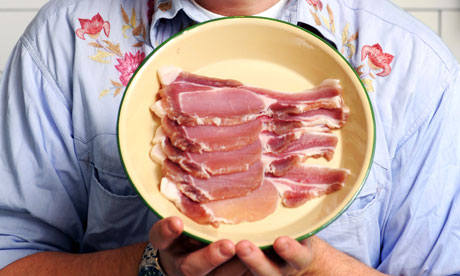
I do hope you weren't reading the paper or listening to the radio this morning as you lovingly sandwiched your crispy rasher or slipped your banger into a bap. The news was frankly awful. According to a study (doesn't your heart just sink when you read those words?) published by the Harvard School of Public Health, on average, each 50g daily serving of processed meat is associated with a 42% higher risk of developing heart disease and a 19% higher risk of developing diabetes. Yep. In a way calculated to get the Daily Mail frothing with excitement, your sausage, bacon or indeed ham, salami or hot dog "raises risk of heart disease by half".
Or possibly not. As if to remind us how utterly fatuous and counter-productive such studies are, thanks to the efforts of researchers from the University of Alabama at Birmingham the following headline appeared in today's Telegraph: "A high-fat breakfast of bacon and eggs may be the healthiest start to the day, report shows".
There is a bright side even to the Harvard research (free extract here) for we confirmed carnivores. It looks like unprocessed meat - you know, all those dripping steaks, fatty pork chops and heart-stoppingly lovely lamb kebabs - get an absolutely clean bill of health. According to Renata Micha, a research fellow in the department of epidemiology at HSPH and lead author of the study. "Most prior studies also did not separately consider the health effects of eating unprocessed red versus processed meats."
This doesn't come as much of a surprise to anyone who loves and regularly cooks meat. Good fresh meat feels inherently right whilst industrially produced preserved meat products have always aroused a certain suspicion. We don't know what awful parts of the animal go into the grinder and we're never quite sure what noxious additives make it last so long.
That's probably why many of us are now experimenting with our own hams, sausages, bacons and salamis. We want to control that process and, for us, the Harvard findings are fascinating. How does taking a couple of kilos of (according to Harvard) zero risk pork and shoving it into a skin with some seasoning make it (according to Harvard) quite so lethal? How does hanging a pig's leg in a cool place for a couple of months take it from benign to life threatening?
The study puts the blame - with some careful get-out clauses - on the "salt and preservatives" used in the processing, which seems logical. At least it would if the connection between heart disease and salt intake weren't so hotly debated.
Just to recap where we are on this, research now indicates that excess salt can cause increased blood pressure in those predisposed to it. High BP is a factor in many deaths from heart disease. By this logic, any organisation with an interest in reducing deaths from heart disease across a population will, without a shadow of a doubt, achieve their aim by reducing salt intake for everyone. Several organisations have already interpreted the Harvard findings with such a slant.
The problem with such epidemiological strategies is that they are irrelevant on an individual level. Unless my doctor can establish that a) I am predisposed to increased BP, b) that my body reacts to salt by increasing my BP and c) that my increased BP is going to result in heart disease and death - which of course doesn't necessarily follow - I might as well be increasing my intake of pickled eggs as decreasing my salt for all the good it will do me.
It's this fundamental discrepancy between epidemiological and individual diagnosis and action that enabled cigarette companies to deny the connection of smoking with cancer for generations in the face of overwhelming evidence, which enables governments to justify 'initiatives' as patently ludicrous as 'five-a-day' and ultimately leads many thinking food lovers to ignore all such dietary advice in bulk.
Salt is one of the factors affecting the outcomes of the study on an epidemiological level. The other is 'nitrates', widely used in the industrial food processing world, partly to preserve an appetising pink hue in products which would otherwise present as universally beige; partly to eliminate the risk of poisoning from botulism, a problem which could arguably be dealt with with better food hygiene procedures during processing.
What these findings will sadly not produce is a backlash against lousy meat processing companies who convert brine-tumesced factory pigmeat and abattoir sweepings into pink shrinkwrapped variety meats and tout them to the general public. This is a wasted opportunity.
Like all similar studies, this one will end up with recommendations to consume processed meat products in moderation and be forgotten in a week once the Mail finds something new to panic about, an erroneous notion that hummus produces bowel cancer in rats, for example. The fact we can now scarf every other kind of flesh with impunity is something of an extra bonus.
It will be a real shame, though, if it gives anyone the slightest pause before diving into a slice of bacon or a sausage from a quality, independent producer (most of whom use only the most limited amounts of nitrates, if any at all). But perhaps the best result would be if we all got busy and started curing our own. It's phenomenally easy to make your own bangers as I discovered last year and you can experiment endlessly with the seasoning - a dash of nutmeg here, a bit of sage there. Has anyone given it a go?

